Papers by Wijnand Helfrich
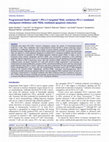
European Journal of Cancer, Jul 1, 2016
Antibodies that block PD-L1/PD-1 immune checkpoints restore the activity of functionally-impaired... more Antibodies that block PD-L1/PD-1 immune checkpoints restore the activity of functionally-impaired antitumor T cells. These antibodies show unprecedented clinical benefit in various advanced cancers, particularly in melanoma. However, only a subset of cancer patients responds to current PD-L1/PD-1blocking strategies, highlighting the need for further advancements in PD-L1/PD-1-based immunotherapy. Here, we report on a novel approach designed to combine PD-L1 checkpoint inhibition with the tumorselective induction of apoptosis by TNF-related Apoptosis Inducing Ligand (TRAIL). In brief, a new bifunctional fusion protein, designated anti-PD-L1:TRAIL, was constructed comprising a PD-L1-blocking antibody fragment genetically fused to the extracellular domain of the pro-apoptotic tumoricidal protein TRAIL. Treatment of PD-L1-expressing cancer cells with anti-PD-L1:TRAIL induced PD-L1-directed TRAILmediated cancer cell death. Treatment of T cells with anti-PD-L1:TRAIL augmented T cell activation, as evidenced by increased proliferation, secretion of IFNg and enhanced killing of cancer cell lines and primary patient-derived cancer cells in mixed T cell/cancer cell culture experiments. Of note, elevated levels of IFNg further upregulated PD-L1 on cancer cells and simultaneously sensitized cancer cells to TRAIL-mediated apoptosis by anti-PD-L1:TRAIL. Additionally, anti-PD-L1:TRAIL converted immunosuppressive PD-L1expressing myeloid cells into pro-apoptotic effector cells that triggered TRAIL-mediated cancer cell death. In conclusion, combining PD-L1 checkpoint inhibition with TRAIL-mediated induction of apoptosis using anti-PD-L1:TRAIL yields promising multi-fold and mutually reinforcing anticancer activity that may be exploited to enhance the efficacy of therapeutic PD-L1/PD-1 checkpoint inhibition.
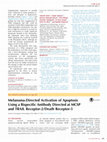
European Journal of Cancer, Jul 1, 2016
lymphopoietin expression in parallel with a reduction in serine protease activity and elevation i... more lymphopoietin expression in parallel with a reduction in serine protease activity and elevation in b-glucocerebrosidase activity (Figures 1 and 2, and Supplementary Figures S1 and S2), suggesting not only that coapplication of PAR2 antagonist and LBA could be involved in both PAR2-independent and PAR2-dependent mechanisms, but also that it might be essential to account for both mechanisms to confer significant therapeutic benefits in AD. Meanwhile, the antipruritic effect from inhibiting PAR2 signaling also could be involved in the therapeutic effects, although we could not evaluate quantitatively the degree of itch in this study. This study demonstrates that coapplications of a PAR2 antagonist and the polyhydroxy acid LBA could represent a novel therapeutic strategy that simultaneously addresses the two mechanisms of AD pathogenesis, namely, skin barrier abnormality and allergic inflammation. The study results form the basis for further evaluation of this strategy in other AD animal models and in human AD. All experiments with mice were approved by the Ethics of Animal Experimentation Committee of Oita University.
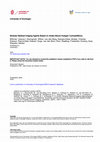
Chemistry: A European Journal, Jul 21, 2020
Since the seminal contributiono fR olf Huisgent o develop the [3+ +2] cycloaddition of 1,3-dipola... more Since the seminal contributiono fR olf Huisgent o develop the [3+ +2] cycloaddition of 1,3-dipolar compounds, its azide-alkyne variant hase stablished itself as the key step in numerouso rganic syntheses and bioorthogonal processes in materials science and chemical biology.I nt he present study,t he copper(I)-catalyzed azide-alkyne cycloaddition was appliedf or the development of am odular molecular platform for medicali magingo ft he prostate-specific membrane antigen (PSMA), using positron emission tomography. This process is shown from molecular design, through synthesis automation and in vitro studies, all the way to pre-clinical in vivo evaluation of fluorine-18-l abeled PSMA-targeting 'F-PSMA-MIC' radiotracers (t1 = 2 = 109.7 min). Pre-clinical data indicatet hat the modular PSMA-scaffold hass imilar binding affinity and imaging properties to the clinically used [ 68 Ga]PSMA-11. Furthermore,w ed emonstrated that targeting the arene-binding in PSMA, facilitatedt hrough the [3+ +2]cycloaddition, can improve binding affinity,w hich was rationalized by molecular modeling. The here presented PSMA-binding scaffold potentially facilitates easy coupling to other medical imaging moieties, enabling future developmentso fn ew modularimaging agents.

Purpose: Adoptive T-cell therapy generally fails to induce meaningful anticancer responses in pat... more Purpose: Adoptive T-cell therapy generally fails to induce meaningful anticancer responses in patients with solid tumors. Here, we present a novel strategy designed to selectively enhance the tumoricidal activity of T cells by targeted delivery of TNF-related apoptosis-inducing ligand (TRAIL) to the T-cell surface.Experimental Design: We constructed two recombinant fusion proteins, anti-CD3:TRAIL and K12:TRAIL. Tumoricidal activity of T cells in the presence of these fusion proteins was assessed in solid tumor cell lines, primary patient-derived malignant cells, and in a murine xenograft model.Results: When added to T cells, K12:TRAIL and anti-CD3:TRAIL selectively bind to the T-cell surface antigens CD3 and CD7, respectively, leading to cell surface accretion of TRAIL. Subsequently, anti-CD3:TRAIL and K12:TRAIL increased the tumoricidal activity of T cells toward cancer cell lines and primary patient-derived malignant cells by more than 500-fold. Furthermore, T-cell surface delivery of TRAIL strongly inhibited tumor growth and increased survival time of xenografted mice more than 6-fold.Conclusions: Targeted delivery of TRAIL to cell surface antigens of T cells potently enhances the tumoricidal activity of T cells. This approach may be generally applicable to enhance the efficacy of adoptive T-cell therapy. Clin Cancer Res; 17(17); 5626–37. ©2011 AACR.
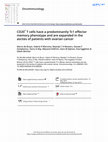
OncoImmunology, Mar 19, 2015
Recently, a small subset of T cells that expresses the B cell marker CD20 has been identified in ... more Recently, a small subset of T cells that expresses the B cell marker CD20 has been identified in healthy volunteers and in patients with rheumatoid arthritis and multiple sclerosis. The origin of these CD20-positive T cells as well as their relevance in human disease remains unclear. Here, we identified that after functional B cell/T cell interaction CD20 molecules are transferred to the cell surface of T cells by trogocytosis together with the established trogocytosis marker HLA-DR. Further, the presence of CD20 on isolated CD20 C T cells remained stable for up to 48h of ex vivo culture. These CD20 C T cells almost exclusively produced IFNg (»70% vs. »20% in the CD20 ¡ T cell population) and were predominantly (CD8 C) effector memory T cells (»60-70%). This IFNg producing and effector memory phenotype was also determined for CD20 C T cells as detected in the peripheral blood and ascitic fluids of ovarian cancer (OC) patients. In the latter, the percentage of CD20 C T cells was further strongly increased (from »6% in peripheral blood to 23% in ascitic fluid). Taken together, the data presented here indicate that CD20 is transferred to T cells upon intimate T cell/B cell interaction. Further, CD20 C T cells are of memory and IFNg producing phenotype and are present in increased amounts in ascitic fluid of OC patients.
Journal of Investigative Dermatology, Nov 1, 2019
Take-down policy If you believe that this document breaches copyright please contact us providing... more Take-down policy If you believe that this document breaches copyright please contact us providing details, and we will remove access to the work immediately and investigate your claim.

Clinical Cancer Research, Sep 1, 2011
Purpose: Adoptive T-cell therapy generally fails to induce meaningful anticancer responses in pat... more Purpose: Adoptive T-cell therapy generally fails to induce meaningful anticancer responses in patients with solid tumors. Here, we present a novel strategy designed to selectively enhance the tumoricidal activity of T cells by targeted delivery of TNF-related apoptosis-inducing ligand (TRAIL) to the T-cell surface. Experimental Design: We constructed two recombinant fusion proteins, anti-CD3:TRAIL and K12: TRAIL. Tumoricidal activity of T cells in the presence of these fusion proteins was assessed in solid tumor cell lines, primary patient-derived malignant cells, and in a murine xenograft model. Results: When added to T cells, K12:TRAIL and anti-CD3:TRAIL selectively bind to the T-cell surface antigens CD3 and CD7, respectively, leading to cell surface accretion of TRAIL. Subsequently, anti-CD3: TRAIL and K12:TRAIL increased the tumoricidal activity of T cells toward cancer cell lines and primary patient-derived malignant cells by more than 500-fold. Furthermore, T-cell surface delivery of TRAIL strongly inhibited tumor growth and increased survival time of xenografted mice more than 6-fold. Conclusions: Targeted delivery of TRAIL to cell surface antigens of T cells potently enhances the tumoricidal activity of T cells. This approach may be generally applicable to enhance the efficacy of adoptive T-cell therapy. Clin Cancer Res; 17(17); 5626-37. Ó2011 AACR.

Cancer Research, Jul 1, 2018
PD-L1-blocking antibodies produce significant clinical benefit in selected cancer patients by rea... more PD-L1-blocking antibodies produce significant clinical benefit in selected cancer patients by reactivating functionally-impaired anticancer T cells. However, their efficacy is potentially reduced by ‘on-target/off-tumor' binding to PD-L1 widely expressed on normal cells. This lack of tumor selectivity potentially induces a generalized activation of all antigen-experienced T cells as is evidenced by frequent autoimmune-related adverse events during and after treatment. To address these issues, we constructed a tetravalent bispecific antibody (bsAb), designated PD-L1xEGFR, to direct PD-L1-blockade to EGFR-expressing cancer cells and thus reactivate anticancer T cells more selectively. The IC50 of PD-L1xEGFR for binding to EGFR+ cancer cells was ~140 fold lower compared to an analogous PD-L1-blocking bsAb of irrelevant target antigen specificity (PD-L1xMock). Importantly, treatment with PD-L1xEGFR selectively enhanced activation status, INF-γ production, and activity of anti-CD3xanti-EpCAM-redirected T cells in presence of EGFR+/EpCAM+, but not EGFR-/EpCAM+ carcinoma cells. Similarly, capacity of PD-L1xEGFR to promote proliferation and IFN-γ production by CMVpp65-specific CD8+ effector T cells was enhanced in the presence of EGFR+/CMVpp65+ cancer cells. In contrast, the clinically-used PD-L1-blocking antibody MEDI4736 (durvalumab) promoted T cell activation indiscriminate of EGFR expression on cancer cells. Additionally, in tumor-bearing mice 111In-PD-L1xEGFR showed a significantly higher tumor uptake compared to 111In-PD-L1xMock. In conclusion, PD-L1xEGFR blocks the PD-1/PD-L1 immune checkpoint in an EGFR-directed manner, which promotes a more selective reactivation of anticancer T cells. This novel targeted approach may be useful to enhance efficacy and safety of PD-1/PD-L1 checkpoint blockade in EGFR-overexpressing malignancies. Citation Format: Iris Koopmans, Douwe F. Samplonius, Robert J. van Ginkel, Peter J. Wierstra, Sandra Heskamp, Edwin Bremer, Wijnand Helfrich. A novel bispecific antibody for EGFR-directed blockade of the PD-1/PD-L1 immune checkpoint [abstract]. In: Proceedings of the American Association for Cancer Research Annual Meeting 2018; 2018 Apr 14-18; Chicago, IL. Philadelphia (PA): AACR; Cancer Res 2018;78(13 Suppl):Abstract nr 4553.
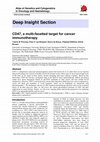
Atlas of genetics and cytogenetics in oncology and haematology, Apr 1, 2017
CD47 is a ubiquitously expressed immunoregulatory protein best known for its so-called 'don't eat... more CD47 is a ubiquitously expressed immunoregulatory protein best known for its so-called 'don't eat me' function that prevents phagocytic removal of healthy cells by the immune system. Many types of cancer present high levels of this don't eat me signal on their surface, thereby disrupting anti-cancer immune responses. Based on this observation, CD47 has become a prominent target in the field of cancer immunotherapy. Indeed, pre-clinical studies have shown therapeutic benefit of anti-CD47 antibodies in solid cancers and most notably B-cell malignancies. However, CD47 is also involved in various other important cellular processes, such as angiogenesis, cancer cell death and regulation of T-cell immunity, which can be modulated via interactions with thrombospondin-1. The therapeutic outcome of CD47-targeted immunotherapy therefore relies on the combined effects of all these processes. Here we will review the various physiological functions of CD47 and their implications in cancer biology. Further, we will review ongoing efforts and provide perspectives for exploiting CD47 as an immunotherapeutic target in cancer.

Uploads
Papers by Wijnand Helfrich